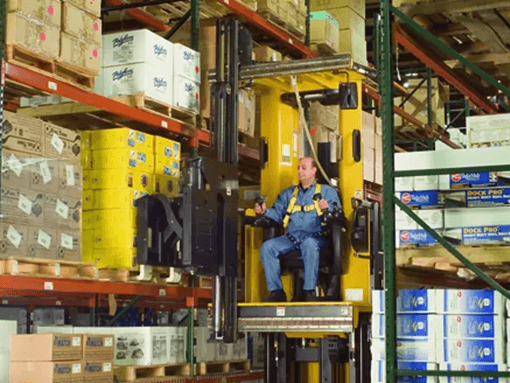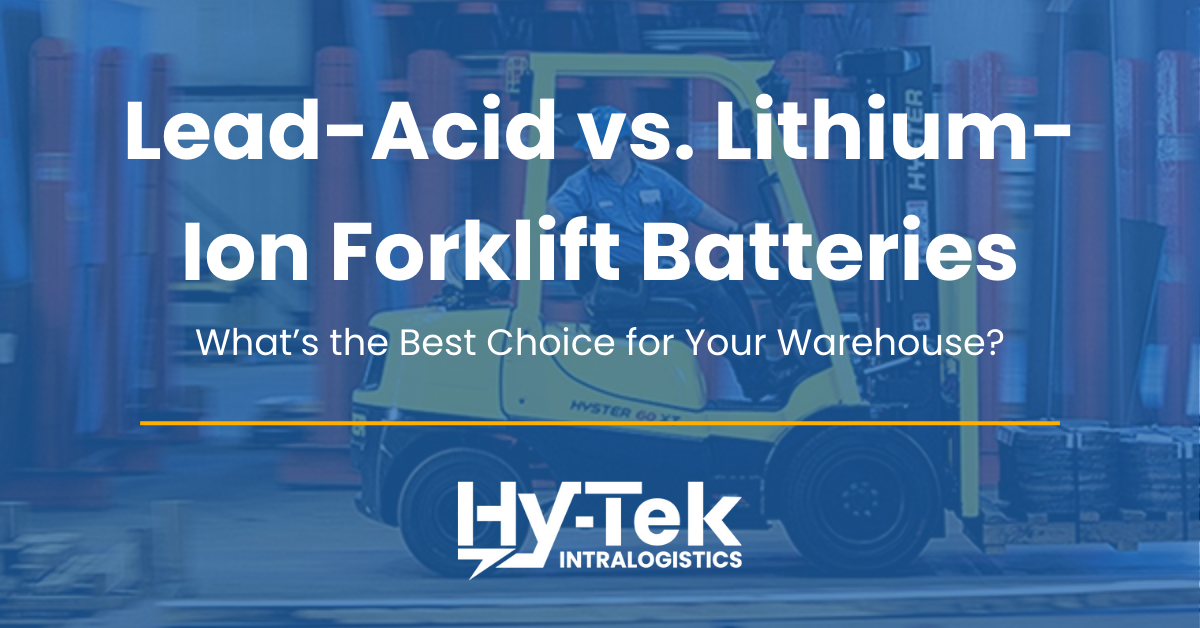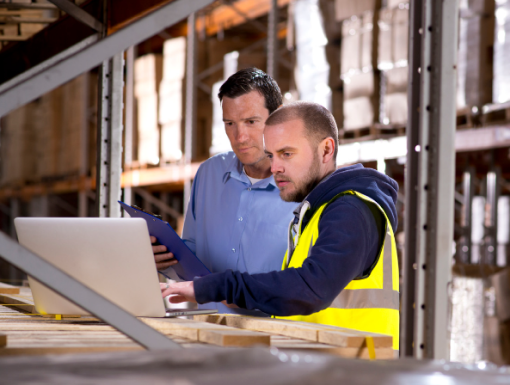Forklifts are categorized by their class, which ranges from 1 to 7.
Here we will only be focusing on class 2 forklifts, also known as electric narrow aisle trucks.
Narrow aisle forklifts are built to work in areas narrower than 12 feet.
They have cushion tires that are airless rubber tires, which means they are only operated indoors.
Learn the Basics of Forklifts Class 1 through 5
The typical function of class 2 forklifts is to reach high shelves to load and unload pallets.
These lift heights vary based on the model but the minimum reach height of a class 2 truck is about 20 feet and certain models, like the turret truck, will go up to 40 feet.
Due to the extreme lift heights, class 2 forklifts have a max lift capacity of around 3,500 lbs typically.
However, there are some reach truck models (usually the sit-down trucks) that have a lifting capacity of up to 5,500 lbs.
Class 2 Key Features
- Load Capacity- How much weight the forklift can lift up and move.
- Lift Height- The maximum height (in inches) that a specific forklift model can lift. This varies based on the model and mast stages.
- Mast Height Lowered- The height of the very top of the forklift mast when lowered all the way.
- Lowering Speed- The speed at which the forklift can lower the forks when taking a load from a shelf to the ground. This is typically measured in feet/min.
- Lift Speed- The speed at which the truck can raise the forks in an upward motion. Typically measured in feet/min. This is important to know so that warehouse managers can project orders picked per hour.
- Max Travel Speed- For Class 2 it varies from 6 mph to 8.7 mph depending on the model. Stand-up forklifts travel the slowest.
- Battery Voltage- There are four types for class 2: 24V, 36V, 48V, and 72V.
What is a Class 2 Forklift?
Class 2 forklifts can be defined as electric-powered forklifts that are built for narrow aisle applications with tight maneuverability. They are ideal for picking and some may even have double-deep reach capabilities, which allow them to pick pallets from the second position. The best applications for these trucks are large, dense storage warehouses, high-shelf applications, and high-volume handling warehouses.
Class 2 Forklift Carriage Dimensions
For those who don’t know the forklift carriage is the rectangular component that the forks and back rest attach to. It sits in front of the mast, with mast chains that allow for loads to travel up and down with the mast.
Carriage height: 16″
Lift Capacity: 2,200 – 5,500 lbs.
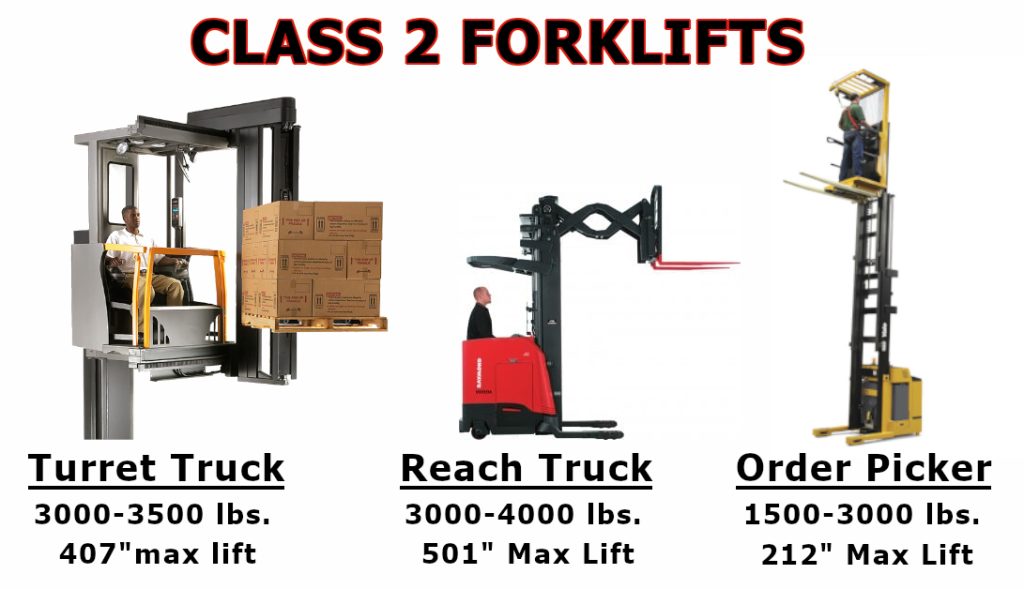
Class 2 Forklift Types
There are 3 model types for class 2 forklifts: Very Narrow Aisle Forklifts, Reach Trucks, and Order Pickers.
Below we will take a deeper look at each model.

Very Narrow Aisle Forklifts
Very narrow aisle trucks (also referred to as turret trucks) are made to optimize storage capacity and efficiently retrieve pallets in high-intensity operations.
These machines allow you to incorporate more racking into your warehouse, which provides more pick locations and allows a greater number of SKU’s (Stock keeping units) to be stored in your warehouse.
An articulating carriage allows the forks to rotate 180⁰ within the storage aisle.
This means the forks can rotate sideways without requiring you to move the entire truck.
As a result of this, the turret truck can navigate comfortably in spaces as small as 60″.
The main mast can reach a maximum height of 40 feet.
The entire carriage moves with the mast, so when raising and lowering the operator will go up and down with the forks, giving the operator a clear view of his/her picking area.
While these machines are uncommon and are only used in industries that require tight spaces, they usually cost between $35,000-50,000.
Industries that use turret trucks include auto parts distributors, furniture warehouses, health and pharmacy warehouses, and e-commerce foods.
Click here to see the full brochure and spec sheet for a turret truck.
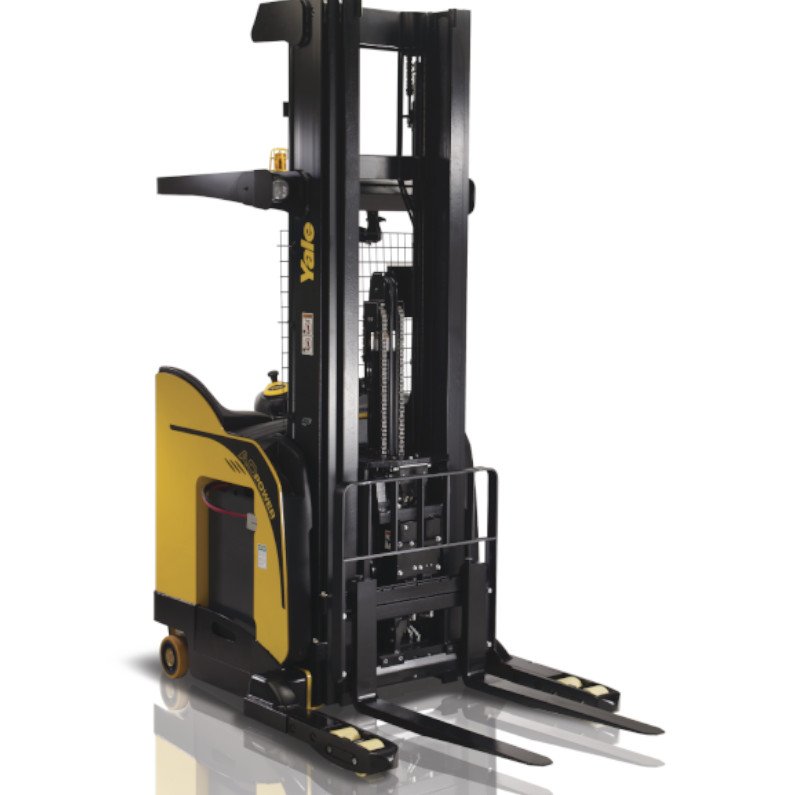
Reach Trucks
Out of all the class 2 lift trucks, reach trucks take up the smallest space.
Like all class 2 forklifts, the reach truck is best for storing and retrieving pallets in racks.
Reach trucks come equipped with a pantograph mechanism, allowing the forks to reach beyond the first shelf and place pallets two-deep on a shelf.
One of the best applications to have these forklifts in are FIFO (First In First Out) or FILO (First In Last Out) storage racks.
Generally reach trucks have a load capacity between 3,000 and 4,000 lbs.
The standard factory model reach trucks can reach a maximum fork height of 25 feet.
However, the newer premium models have a max fork height of 42 feet.
Reach trucks are extremely common and cost between $25,000 to 45,000 for brand new models.
The industries that use these forklifts the most are cold & frozen foods, retail store operations, food distribution, furniture warehouses, home centers, and health and pharmacy.
Click here to see the full brochure and spec sheet for a reach truck.

Order Pickers
Order pickers (sometimes called order selectors) are used most frequently in warehouses for fulfillment.
These trucks are designed to lift the operator while making picks.
This is done by connecting the forks to the operator platform so that when raising and lowering pallets the operator has a clear view of their pick.
However, operators often lean out over the platform and grab products or items off of shelves.
Because of this order pickers have a belt and cord connected to their frame that the operator will harness himself/herself into when operating.
The base of the forklift (battery, frame, and wheelbase) remains on the ground while the platform, controls, and mast move up and down.
Unlike the reach truck, order pickers do not have a pantograph mechanism.
This means the forks cannot extend inward and outward, only up and down.
The order selector is great for narrow aisles, it has an overall width of about 50 inches and a turning radius between 65 and 70 inches.
Order pickers have a lift height between 18 and 25 feet with load capacity between 1,500 to 3,000 lbs.
These trucks will typically fall in the price range of $30,000 to $40,000.
The industries that use order pickers the most frequent are food and beverage, health and pharmacy, retail stores, and home centers
Click here to see the full brochure and spec sheet for an order picker.

Power Options
Every Class 2 forklift is powered by an electric battery.
There are 3 different ways to deliver power. Lead-Acid batteries, Lithium-Ion batteries, and hydrogen fuel cells.
The battery is the most expensive part of class 1 lift trucks, costing anywhere from $6,500 to $15,000 for a new forklift battery.
36V batteries are between $6,500-$14,800, whereas 80V batteries can cost anywhere from $9,900-$14,300.
Order pickers either use a 24V or 36V and reach trucks usually have a 36V or 48V battery, whereas turret trucks utilize a 48V or 72V battery.
It all depends on the size and how many amp-hours are needed.
Therefore, when making a decision on purchasing a new or used forklift you always want to get a high-quality battery with little to no prior use.
There are 2 main types of batteries: lithium-ion and lead-acid.
Lead-Acid Batteries
While providing electricity is the main purpose of having a lead-acid battery, it also serves as a weight to help balance your forklift when lifting heavy materials.
This is extremely important for class 2 forklifts since they are used to reach the higher shelves in warehouses.
These batteries are much cheaper than lithium-ion or hydrogen fuel cell options but like many cases, you get what you pay for.
There are two kinds, thin-plate and tubular lead-acid batteries.
Thin-plates are a newer and more advanced battery when compared to tubular.
They have a higher upfront cost but longer run time, quicker charging, and less maintenance.
High upkeep is required to keep tubular lead-acid batteries running well and charging times can shoot down your uptime.
If you are running one-shift a day for 3-5 days a week this could be a good fit for you, it depends heavily on your application.
Lithium-Ion Batteries
The alternative and more expensive to lead-acid, lithium-ion batteries bring greater ROI due to extended battery lifespan (2-3X longer) and faster charge times.
These batteries are used most in warehouses that require a heavy workload on their fleet.
This means that the forklifts are run 2-3 shifts a day and are required to have fast charge times in order to take advantage of short operator breaks (lunch break or shift change).
Lithium batteries provide operations managers the ability to utilize fast charging or opportunity charging and they do not experience as quick of a discharge rate over their lifespan.
Lastly, these batteries need very little charging space which frees up space for more SKUs or operations.
Lithium-ion batteries are clearly the better battery with higher returns, but they aren’t needed in every application.
Some places only require single shifts and thus the added price to purchase a lithium-ion battery would not make sense.
The other reason why companies choose lead-acid over lithium-ion is because of the upfront costs. Lead acid is 2-3X cheaper, which makes lithium-ion a hard sell.
View the head to head comparison of lead-acid vs lithium-ion batteries here.
Hydrogen Fuel Cells
Hydrogen fuel cell batteries are a newer technology in the forklift industry.
I have a very basic knowledge of how these work, but they basically combine hydrogen fuel with oxygen to produce electricity.
Due to growing environmental awareness corporations have established environmental wellness initiatives centered around preserving natural resources and using clean energy.
As a result, hydrogen fuel cells are targeting environmental safety, lower operating costs, and increasing reliability.
Despite this, these batteries are not only expensive but they come with a hefty installation/infrastructure overhaul.
Today, hydrogen can either be delivered to a customer location or generated on-site.
Delivery options range from gaseous hydrogen shipped via tube trailers for lower-volume usage or liquid state hydrogen for higher-volume applications.
Common advantages of hydrogen fuel cells are constant voltage fuel tanks until depletion, no performance degradation, no battery discharge, lower fuel emissions, and no battery swapping, saving warehouses lost productivity.
I’m nowhere near an expert on chemical properties so if you’d like a deeper dive into the build and functions of a hydrogen fuel cell battery I would read this article by Battery University.
The best fits for hydrogen fuel cells are:
- Multi-shift operations that want to reduce downtime and increase efficiency
- Growing operations that need additional indoor space
- Organizations looking to lower their carbon footprint
- Confined settings that require high air quality for employee safety
Further Reading
FAQ
What is a Turret Truck?
A turret truck is a class 2 forklift that is built to work in very narrow aisles (8-9 feet aisles). Turret trucks are powered by a battery and an electric engine. They are built to reach high pallets on shelves, up to 40 feet, and have load capacities between 3,000 and 3,500 lbs.
What is a Reach Truck Forklift?
A reach truck is a class 2 forklift that operates in very narrow aisles (8-9 feet aisles). Reach trucks use a 36V or 48V electric battery and an electric engine. Their main function is to store and grab pallets from high shelves, up to 30 feet.
What is an Order Picker?
An order picker or order selector is a class 2 forklift that is designed to work in very narrow aisles (8-9 foot aisles width). Order pickers use a 24V or 36V electric battery and electric engine for power. Their main purpose is to lift operators up next to shelves so that they can select and grab exact items or products.

